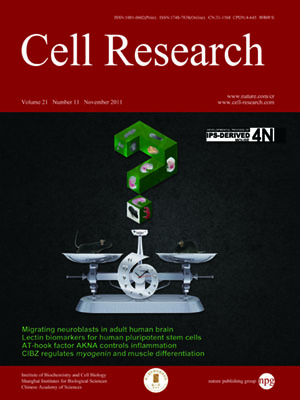
Volume 21, No 11, Nov 2011
ISSN: 1001-0602
EISSN: 1748-7838 2018
impact factor 17.848*
(Clarivate Analytics, 2019)
Volume 21 Issue 11, November 2011: 1564-1577
ORIGINAL ARTICLES
Coordinate activation of inflammatory gene networks, alveolar destruction and neonatal death in AKNA deficient mice
Wenbin Ma1,*, Blanca Ortiz-Quintero1,*, Roberto Rangel1, Morgan R McKeller1, Sara Herrera-Rodriguez1, Eliseo F Castillo1, Kimberly S Schluns1, Mary Hall1, Huiyuan
1Department of Immunology, Unit 902, The University of Texas MD Anderson Cancer Center, 7455 Fannin Street, Houston, TX 77054, USA
2Immune Regulation Laboratory, Institut de Recherches Cliniques de Montr閍l (IRCM), Montr閍l, QC, Canada H2W 1R7
3The Campbell Family Institute for Breast Cancer Research, University Health Network, Toronto, ON, Canada M5G 2C1
4Department of Biochemistry and Molecular Biology, The University of Texas-Houston Medical School, Houston, TX 77030, USA
Correspondence: Hector Martinez-Valdez,(hmartine@mdanderson.org)
Gene expression can be regulated by chromatin modifiers, transcription factors and proteins that modulate DNA architecture. Among the latter, AT-hook transcription factors have emerged as multifaceted regulators that can activate or repress broad A/T-rich gene networks. Thus, alterations of AT-hook genes could affect the transcription of multiple genes causing global cell dysfunction. Here we report that targeted deletions of mouse AKNA, a hypothetical AT-hook-like transcription factor, sensitize mice to pathogen-induced inflammation and cause sudden neonatal death. Compared with wild-type littermates, AKNA KO mice appeared weak, failed to thrive and most died by postnatal day 10. Systemic inflammation, predominantly in the lungs, was accompanied by enhanced leukocyte infiltration and alveolar destruction. Cytologic, immunohistochemical and molecular analyses revealed CD11b+Gr1+ neutrophils as major tissue infiltrators, neutrophilic granule protein, cathelin-related antimicrobial peptide and S100A8/9 as neutrophil-specific chemoattracting factors, interleukin-1β and interferon-γ as proinflammatory mediators, and matrix metalloprotease 9 as a plausible proteolytic trigger of alveolar damage. AKNA KO bone marrow transplants in wild-type recipients reproduced the severe pathogen-induced reactions and confirmed the involvement of neutrophils in acute inflammation. Moreover, promoter/reporter experiments showed that AKNA could act as a gene repressor. Our results support the concept of coordinated pathway-specific gene regulation functions modulating the intensity of inflammatory responses, reveal neutrophils as prominent mediators of acute inflammation and suggest mechanisms underlying the triggering of acute and potentially fatal immune reactions.
Cell Research (2011) 21:1564-1577. doi:10.1038/cr.2011.84; published online 24 May 2011
FULL TEXT | PDF
Browse 2020


